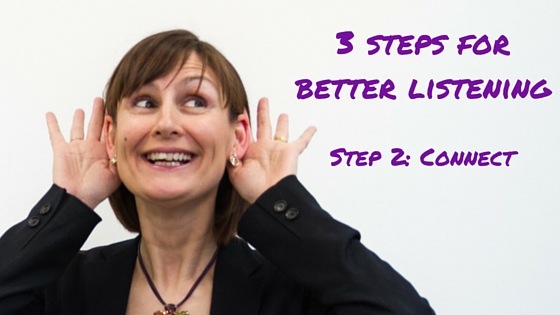In Step 1 of this series, we talked about preparing to listen by removing distractions and empathizing.
Once you’re ready to focus on the other person, use these four simple ways to connect in a conversation.
Four Simple Ways to Connect in Conversation
1. Make eye contact
Yes, some cultures consider eye contact disrespectful, but my aim is to help people in the global business culture, which has a heavy Western influence. Eye contact demonstrates confidence and caring.
Look the person in they eye when they’re speaking to you. The speaker appreciates this as a sign that you’re listening, and that helps you to connect.
If the speaker looks upward, to the side, or downward, don’t worry. It’s natural to break eye contact while thinking what to say or remembering.
Let them think, and then be ready to reconnect with eye contact when they look at you again.
2. Pay attention to nonverbals
Eye movement is an example of a nonverbal cue in a conversation.
Other nonverbal cues are facial expression, posture, gestures, tone of voice, and such.
Pay attention to these to really listen to the other person and understand the honne (true feelings) behind the tatemae (facade).
Have you ever asked someone if they’re okay and they say, “Yes, fine.” But their tone of voice doesn’t sound like they’re fine?
If a person’s words don’t communicate the same message as other cues they’re giving, you have a choice. Maybe the conversation or the relationship isn’t so important, so you can ignore it…or you might want to ask about it. This might need tact, and sometimes it’s best to make a mental note and talk with the person at a better time or in a better place.
By paying attention to the nonverbals, you’re listening at a deeper level to help you truly understand the other person. This can be critical in avoiding unproductive workplace conflicts.
3. Acknowledge with your body
Reassure the speaker that you’re listening with your posture and movements.
For example, lean a little toward the person to show interest.
Avoid fidgeting – it suggests that you’re nervous or impatient.
Nod at a pace that matches how the person is speaking and what about. Nod slowly for more serious topics and more quickly for exciting topics.
4. Acknowledge with your voice
Indicate that you’re listening with sounds and words, such as “Uh-huh” and “I see.”
We hear this type of acknowledgment frequently in Japanese conversations, as people say, “Hai, hai.”
Once I was interpreting for an Australian raw materials supplier and Japanese buyer. At the end of the meeting, the Australian beamed, “Well, that went great. He agreed with everything.” I had to explain that even though “hai” means “yes,” it doesn’t necessarily mean agreement – just that the person is listening.
If this type of vocal acknowledgment is too frequent, it can have the reverse effect and give the impression that the person isn’t listening at all, but instead just making automatic sounds while thinking about something else.
* * * * *
How well are you using eye contact, attention to nonverbals, and acknowledgment with your body and voice to connect with people in conversations?
Next week, we’ll look at Step 3: Confirm, in which I’ll introduce two ways to confirm that you’ve understood the other person in a conversation – which is crucial for better results, more efficiency, and less stress.
Working in a global business environment? Keen to improve your communication skills for persuasive presentations and meaningful meetings? I’d love to email you communication tips every Tuesday. Just sign up here for Sasuga! Tips For You.
Thank you for listening!
Thanks, TopTia, for the photo.

